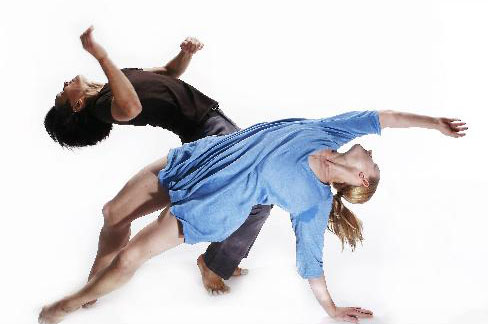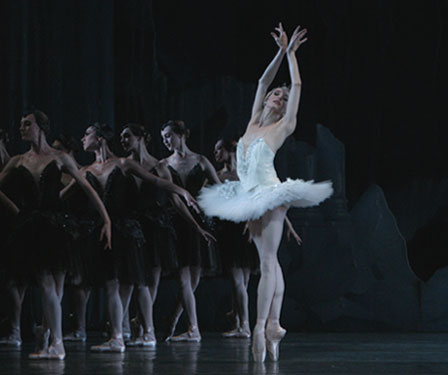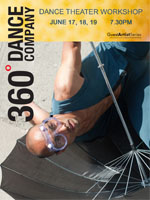Seeing Things: February 2009 Archives
This article originally appeared in the Culture section of Bloomberg News on February 26, 2009.

Dancers Eddie Taketa, left, and Natalie Desch perform in "Alchemy," choreographed by Doug Varone, on Feb. 1, 2008. The dance piece, with music by Steve Reich, is being performed at New York's Joyce Theater through March 1. Photographer: Phil Knott via Bloomberg News
Feb. 26 (Bloomberg) -- A delicately built woman with boyish curly hair stands before a backdrop suggesting a prison of impermeable rock. Her head remains unbowed, her fingers tremble like antennae receiving messages and her eyes are lifted to some indefinable world beyond that still contains hope.
Set to Steve Reich's "Daniel Variations," Doug Varone's "Alchemy," given its New York premiere Tuesday night at New York's Joyce Theater, takes off from a pair of stories -- one ancient, one modern -- referred to in the score. In 2002 the Jewish-American journalist Daniel Pearl was kidnapped by Islamist extremists in Pakistan and hideously murdered. The Daniel of the Old Testament maintains a steadfast faith in God despite life-threatening acts of violence against him; his tale is vivid with apocalyptic visions.
The frail-looking but unwavering woman (Erin Owen) appears to be an amalgam of both Daniels. Fellow captives join her: four men and three women who are repeatedly felled, physically and spiritually, by invisible oppressors who seem inhuman to a degree almost beyond imagination.
The victims never completely give up. They try to comfort one another, but there is no respite from their situation. They crawl along the floor, bodies contorted, struggle to rise only to fall again, flesh and bone thudding against the floor. On occasion they even turn upon one another, reduced to savage animals. Even the Daniel figure eventually succumbs, all hope extinguished.
Golden Glow
But then a golden glow shines down on the distorted, inert bodies. "Daniel" is the first to stand erect, raise her arms to the light, chest throbbing as if she's received a definitive message about the essence of being fully human -- to face the most terrible fates with one's courage and identity intact. Slowly, her companions absorb it.
"Alchemy" is not, by a long shot, the most successful dance Varone has ever choreographed. The general theme suits his gifts but the parallel stories that inspired Reich don't translate well into dance (or into music, for that matter). Varone's attempt to make them work as a semi-abstract version of the haunting facts leaves too much vagueness in the air, which I suspect his fine dancers feel.
Nevertheless, Varone remains one of the most important choreographers on the scene. While not as well known as Paul Taylor, he operates in many genres: opera, spoken theater, the big and small screens -- he may be the busiest choreographer in town.
At the same time, maintaining his own company, creating a repertory for this small group of quietly expressive dancers with unique stage personalities, remains the heart of his work. His pieces for them are typically poignant, often executed in subtly varied emotional shades of gray. They make the viewer feel: Yes, for good and ill, this is what life is like.
"Alchemy" is on a triple bill with the 2006 "Lux" to a Philip Glass score and a reworking of the 2000 "Tomorrow" to luscious Belle Epoque songs by Reynaldo Hahn.
Through March 1 at the Joyce Theater, 175 Eighth Ave. Information: +1-212-242-0800; http://www.joyce.org.
© 2009 Bloomberg L.P. All rights reserved. Reprinted with permission.
New York City Ballet: Revival of Balanchine's Swan Lake / David H. Koch Theater, Lincoln Center, NYC / February 12, 2009

Wendy Whelan was magnificent as Odette. Her many admirers over her long career know that she was born to dance the quirkier, more angular roles in the modern ballet repertory--because of anatomy and perhaps temperament. As time passed, she grew softer and registered more emotion (very delicately). But her Odette is a triumph because she was not made for it nor it for her, and yet she looks as if she has minutely studied and absorbed the interpretations of her predecessors in a variety of distinctive productions and instinctively added some of her own touches. The result is everywhere beautifully executed, right in its intent and feeling, and in no way ballerina-ish, as if her experiences were something that could happen to any sensitive girl sufficiently romantic enough to wander by lakes at dusk.
The full article appeared in Voice of Dance (http://www.voiceofdance.org) on February 13, 2009. To read it, click here.
Sitelines
AJ Ads
 360° Dance Company at DTW offers two socially relevant revivals, Jane Dudley’s solo “Time Is Money” (1932) and Mary Anthony’s “Devil in Massachusetts” (1952) as well as the World Premier of Artistic Director, Martin Lofsnes' "6-1".
360° Dance Company at DTW offers two socially relevant revivals, Jane Dudley’s solo “Time Is Money” (1932) and Mary Anthony’s “Devil in Massachusetts” (1952) as well as the World Premier of Artistic Director, Martin Lofsnes' "6-1".
AJ Blogs
AJBlogCentral | rssculture
Terry Teachout on the arts in New York City
Andrew Taylor on the business of arts & culture
rock culture approximately
Laura Collins-Hughes on arts, culture and coverage
Richard Kessler on arts education
Douglas McLennan's blog
Dalouge Smith advocates for the Arts
Art from the American Outback
Chloe Veltman on how culture will save the world
For immediate release: the arts are marketable
No genre is the new genre
David Jays on theatre and dance
Paul Levy measures the Angles
Judith H. Dobrzynski on Culture
John Rockwell on the arts
innovations and impediments in not-for-profit arts
Jan Herman - arts, media & culture with 'tude
dance
Apollinaire Scherr talks about dance
Tobi Tobias on dance et al...
jazz
Howard Mandel's freelance Urban Improvisation
Focus on New Orleans. Jazz and Other Sounds
Doug Ramsey on Jazz and other matters...
media
Jeff Weinstein's Cultural Mixology
Martha Bayles on Film...
classical music
Fresh ideas on building arts communities
Greg Sandow performs a book-in-progress
Harvey Sachs on music, and various digressions
Bruce Brubaker on all things Piano
Kyle Gann on music after the fact
Greg Sandow on the future of Classical Music
Norman Lebrecht on Shifting Sound Worlds
Joe Horowitz on music
publishing
Jerome Weeks on Books
Scott McLemee on books, ideas & trash-culture ephemera
theatre
Wendy Rosenfield: covering drama, onstage and off
visual
Public Art, Public Space
Regina Hackett takes her Art To Go
John Perreault's art diary
Lee Rosenbaum's Cultural Commentary
